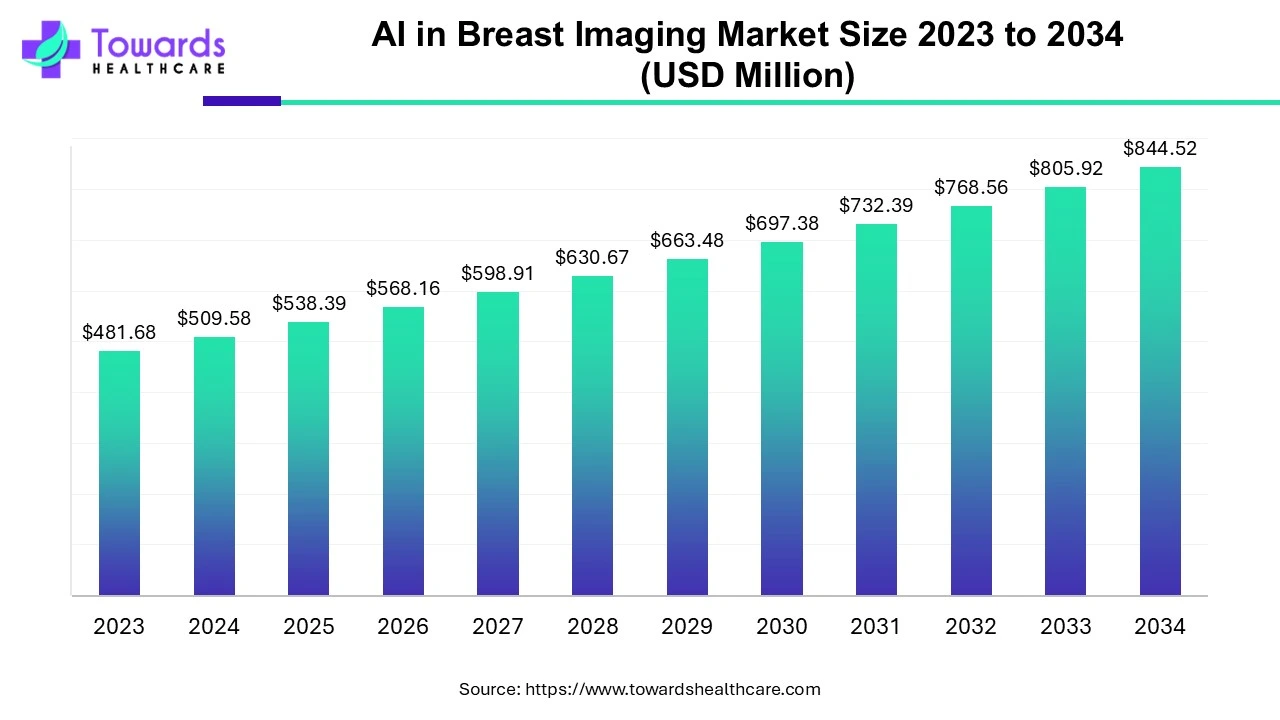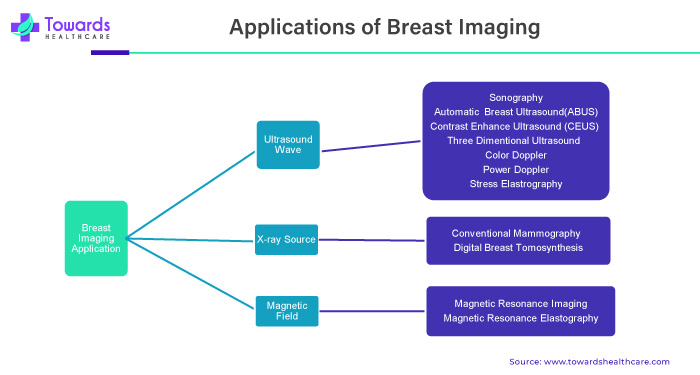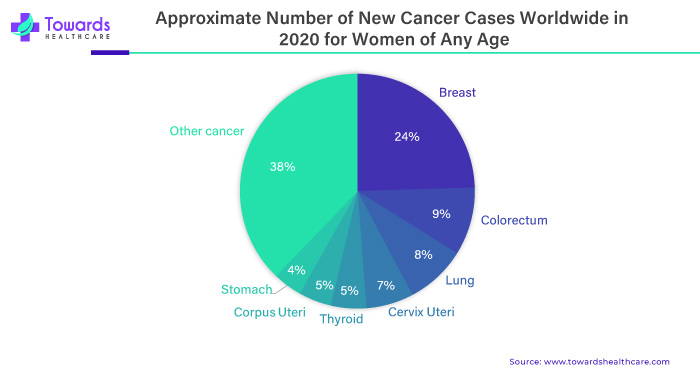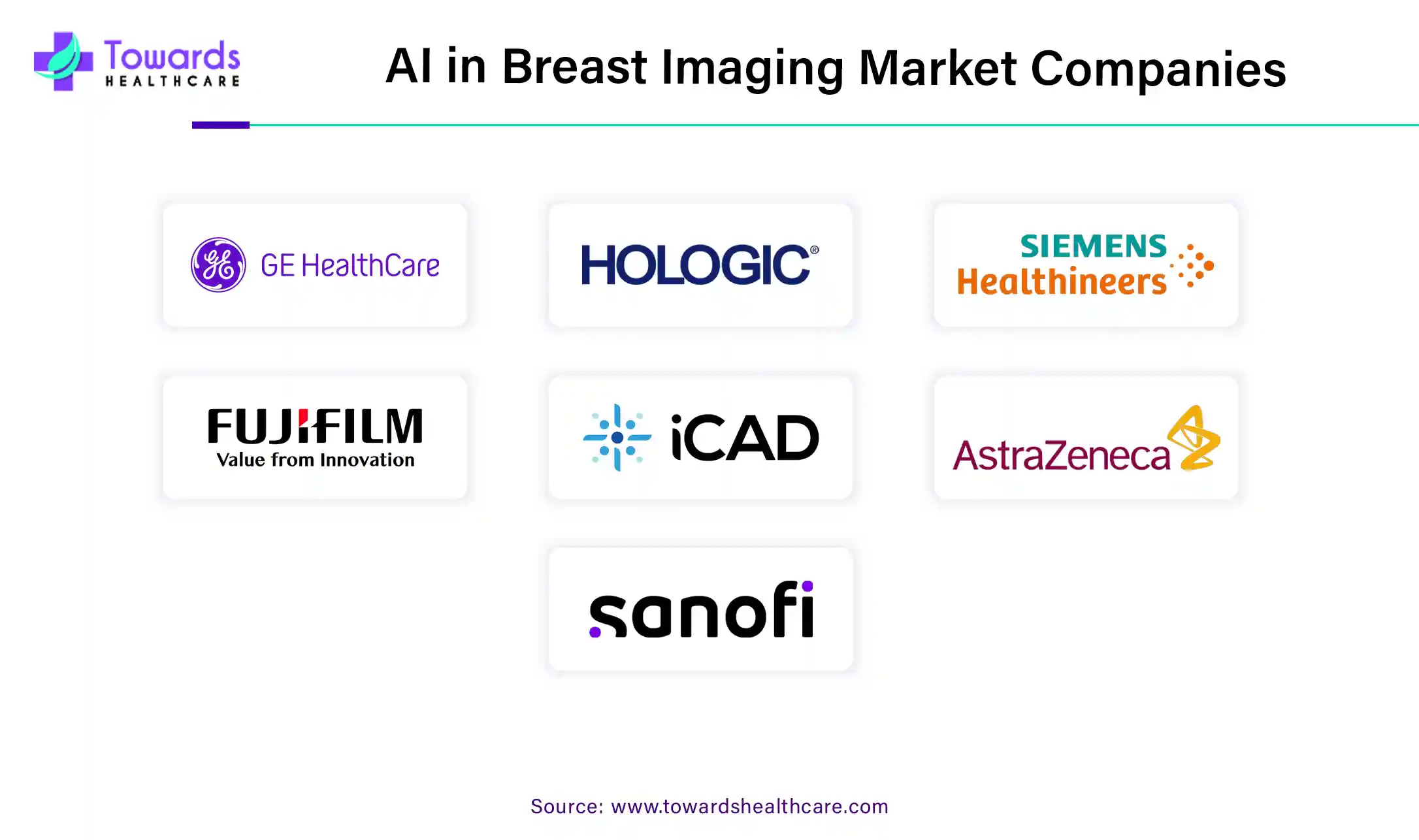April 2025

The global AI in breast imaging market size is projected to reach USD 844.52 million by 2034, expanding from USD 538.39 million in 2025, at an annual growth rate of 3.30% during the forecast period from 2025 to 2034, as a result of the rise in breast cancer prevalence and rising technological advancements.

Artificial intelligence has significantly progressed in various fields, essential to breast imaging. Using machine learning and deep learning, AI analyses huge amounts of data to enhance breast health care in four main areas: Screening, detection, diagnosis, disease monitoring and overall data management. Breast cancer, a significant global health challenge, has been the top cause of cancer-related death among women. AI is making strides in managing clinical data, detecting uncertain cases, predicting outcomes, and organizing data for better clinical decisions.
The advent of promising imaging techniques, such as mammograms, has transformed the treatment of cancer management. Early detection of breast cancer through mammograms, coupled with advanced treatment, has demonstrated a reduction in mortality. The imperative for early detection is underscored, and the integration of AI in breast imaging emerges as a pivotal solution. This growing awareness of the importance of early detection through AI has catalyzed a surge in demand, significantly expanding the Global Market in breast imaging. Artificial intelligence techniques, specifically in Machine Learning and deep learning, have shown impressive advancements in various fields.
Deep learning, a subset of machine learning, has recently been shown in multiple studies to outperform traditional expert-oriented methods when compared to ground truth labels and, in certain task-specific scenarios, to surpass them. Despite its data-hungry nature, deep learning provides thorough management and correlation of concentrated multivariate data, which may have infinite cross-data/case referencing possibilities. For this reason, radiomics' concentrated semantic data, which essentially describe the radiographic aspect of the breast, makes for a highly scientific resource that would be perfect for training a deep learning model.
The application of AI in Breast Imaging has driven advancement by improving diagnostic accuracy, enabling early detection of abnormalities, and enhancing overall efficiency in healthcare processes. AI algorithms assist in analyzing complex imaging data, adding healthcare professionals to make more accurate and timely decisions, ultimately contributing to improved patient outcomes.

Breast cancer is a prevalent global health concern, ranking among the most common cancers worldwide, according to the World Health Organisation (WHO). Breast cancer is the most frequent cancer in women, impacting both developed and developing countries. The prevalence of breast cancers varies geographically and is influenced by factors such as age, genetics, hormonal influences and lifestyle.
For Instance, according to the American Cancer Society 2023 estimates, invasive breast cancer will be diagnosed in women in about 297,790 new cases. There will be roughly 55,720 new diagnoses of Ductal Carcinoma In situ (DCIS). There will be 43,700 female breast cancer deaths.

The prevalence underscores the critical need for early diagnosis, as timely intervention significantly improves treatment outcomes and survival rates. Early detection of breast cancer is crucial for several reasons:
| Improve Treatment Efficacy | Detecting breast cancer at an early stage allows for less aggressive and more effective treatment options. Physical and emotional impact on individuals. This contributes to an improved overall quality of life for breast cancer patients. |
| Reduce Mortality Rate | Early diagnosis substantially decreases the mortality rate associated with breast cancer. |
| Enhance Quality of Life | Early detection, less invasive treatment approaches, minimising the physical and emotional impact on individuals. This contributes to an improved overall quality of life for breast cancer patients. |
The importance of early diagnosis has driven advancement in medical technologies, including AI in breast imaging. AI plays an important role in increasing the accuracy and efficiency of breast cancer detection.
Precision Imaging Analysis
Reduce False Positive
Efficient Screening Processes
Additionally, awareness has grown regarding the significance of early breast cancer detection and the role of AI in improving diagnostic capabilities; there has been a notable increase in the market demand for AI in breast imaging. The integration of AI technologies enhances diagnostic accuracy and almost supports the healthcare system in managing the rising volume of breast screening, thereby contributing to the overall growth of the AI in the breast imaging market.
AI development faces particular opportunities and challenges in the field of breast imaging. The primary form of breast cancer screening is mammography. Application of artificial intelligence, breast density measurement, workflow enhancement, quality assessment, treatment response evaluation, and image enhancement.
The trend toward early detection is attributed to improvements in treatment, increased public awareness of the disease, and earlier detection through breast cancer screening. Next-generation technology advancements are essential for sensitive, accurate, and reasonably priced healthcare. Although biomarkers such as DNA, RNA, Protein, and epigenetics contribute to our understanding of breast cancer, their worldwide non-reproducibility limits their applicability. The best form of prevention is awareness; formalized screening programs are essential to empowering women via self-screening and education. Individuals at high risk can benefit from clinical consultations and counselling.
Moreover, innovation and teamwork are closely associated with the growth of the AI imaging market. The use of artificial intelligence in medical imaging has increased dramatically due to strategic alliances and partnerships. This cooperative approach offers a promising synergy between medical knowledge and cutting-edge technology, improving diagnostic capabilities and playing a critical role in the ongoing fight against breast cancer.
Secure laws are essential protections for patient safety, data security, and the dependability of medical equipment in the healthcare sector. These rules become a safeguard as well as a significant obstacle when it comes to incorporating AI in breast imaging. Healthcare regulations are intended to ensure the moral application of technology in medical settings. Stringent compliance requirements frequently typify them. Compliance in the context of AI applications for breast imaging refers to adhering to guidelines for patient confidentiality, data privacy, and the general safety of the AI algorithms. The safeguarding of private patient information is one important factor. Large datasets, such as patient records and medical images, are frequently the basis for AI systems used in breast imaging. Complying with data privacy regulations, like the US Health Insurance Portability and Accountability Act (HIPAA), complicates the integration process. It is crucial to ensure AI Applications handle patient data securely and keep it private.
Additionally, safety regulations are essential for AI systems employed in medical diagnosis. Regulatory bodies frequently demand thorough validation to prove the accuracy, consistency, and dependability of AI algorithms. Extensive testing on various datasets is part of this validation process to ensure the AI system works well in a range of scenarios and demographics. To successfully navigate these regulatory obstacles, great care must be taken during the development, testing, and implementation stages of AI solutions for breast imaging.
The extensive validation process and strict adherence to compliance guidelines add to the implementation's time-consuming complexity. Companies and developers must spend money on clinical trials, regulatory approvals, and system optimization to meet stringent requirements—the more extended time frames for releasing AI solutions on the market result from these regulatory obstacles. Implementation delays may impact the overall rate of advancement in AI technologies for breast imaging. The complexity of compliance procedures has grown, making things more complicated overall, especially for smaller businesses with fewer resources.
Furthermore, strict healthcare laws are necessary to preserve the accuracy of medical technologies, but they also create barriers to the quick adoption of AI in breast imaging. To fully utilize AI's potential to improve breast cancer detection and diagnosis, stakeholders must balance innovation and compliance.
These factors collectively contribute to the growth of AI in the breast imaging market. Collaboration between hospitals, diagnostic imaging centres, and research institutes fosters an environment where technology continually evolves and proves its value in enhancing breast imaging capabilities. As a result, the market experiences sustained growth driven by the collective efforts to improve efficiency, workflow, and the accuracy of breast imaging through AI applications.
By technology, the computer-aided detection segment held a dominant presence in the market in 2024. Computer-aided detection system is predominantly used to detect breast cancer by analyzing mammograms and other breast imaging scans. According to a study published in March 2025, AI-based computer-aided detection (AI-CAD) increased the cancer detection rates for breast radiologists to interpret screening mammograms. Hence, AI-CAD enhances accuracy, precision, and speed of image analysis. The adoption of CAD in breast imaging has significantly increased since its approval in 1998. The technology is also reimbursable by the Centers for Medicare & Medicaid Services from 2002, thereby potentiating its use.
By technology, the machine learning segment is predicted to witness significant growth in the market over the forecast period. Machine learning (ML) has proved to play a pivotal role in breast imaging like mammograms, ultrasounds, and MRIs. ML analyzes vast amounts of patient data and patient characteristics to detect breast cancer. It can also predict the risk of developing breast cancer in high-risk individuals. The field of ML in breast imaging is rapidly evolving with the latest advancements and diverse applications, assisting radiologists and clinicians. ML also helps healthcare professionals to identify patterns in dense breast tissue where visual detection can be challenging.
By application, the screening segment held the largest share of the market in 2024. AI and ML algorithms have been deployed in numerous detection tools for the initial reading of screening mammograms, thereby significantly increasing breast cancer detection rates. Favorable government initiatives create awareness among the general public to participate in screening programs. The U.S. Preventive Services Task Force and European Commission Initiative on Breast Cancer recommend women of 40-74 years and 50-69 years, respectively, to get a mammogram every two years. This helps oncologists to take preventive measures and cure at an early stage.
By application, the diagnostics segment is projected to expand rapidly in the market in the coming years. The rising incidences and prevalence of breast cancer globally have raised the adoption of advanced technologies like AI for the early detection of breast cancer. AI enhances the efficiency and accuracy in the detection of breast cancer, saving a lot of time for oncologists and reducing manual errors. The advent of point-of-care diagnostics and the burgeoning diagnostics field enable the adoption of AI. Integrating AI in several diagnostic tools increases the speed of cancer detection.
By end-use, the hospitals & clinics segment led the global market in 2024. The segmental growth is attributed to favorable infrastructure and the presence of skilled professionals. The availability of specialized equipment and suitable capital investment also augment the segment’s growth. The increasing number of hospitals & specialized clinics potentiate the use of AI in breast imaging. There are around 72 NCI-designated Cancer Centers in the U.S.
North America dominated the global market in 2024. The rising adoption of advanced technologies and the presence of key players drive the market. Key players such as iCAD, Inc., GE Healthcare, and Hologic, Inc. hold a major market share in North America. The increasing incidences and prevalence of cancer boost the market. American Cancer Society estimated more than 2 million new cancer cases in the U.S. in 2025. Favorable government initiatives, suitable regulatory frameworks, and increasing investments also contribute to the market. There are more than 20 FDA-approved AI applications for breast cancer imaging. The Government of Canada recently announced an investment of $545,000 for two initiatives to advance research and raise awareness for breast cancer screening.
Asia-Pacific is anticipated to grow at the fastest rate in the market during the forecast period. The rising incidences of breast cancer due to the increasing geriatric population boost the market. Countries like China, India, and Japan are at the forefront of driving market growth. Several government and private research institutions conduct workshops, conferences, and symposiums to create awareness among the general public for screening and early detection of breast cancer. Government initiatives like “Made in China” and “Make in India” promote the indigenous development of AI in breast imaging tools or software. The Government of India announced a Rs 36000 crore budget for the National Health Mission as part of the Union Budget FY 2024-25, with a special focus on affordable cancer diagnosis and treatment.
Erik Anderson, President of Breast and Skeletal Health Solutions, Hologic, commented that the company is committed to providing clinicians with effective, equitable solutions to advance breast cancer detection globally. He also said that customers can rely on their latest technology, Genius AI Detection 2.0 software to perform effectively for all patients regardless of race, ethnicity, or background.
The AI in breast imaging offers transformative opportunities across healthcare. AI enhances early detection and diagnosis by improving accuracy through efficient analysis, facilitating timely intervention in breast cancer cases. In personalized medicine, AI analyzes patient history, genetics, and imaging data to tailor treatment plans, optimizing outcomes. Workflow efficiency is boosted as AI automates tasks in breast imaging, streamlining processes, aiding prioritization, and reducing interpretation times.
AI's contribution to research and development lies in its ability to conduct sophisticated analyses of large datasets, advancing the understanding and treatment of breast cancer. AI assists medical professionals in training and education by providing simulations that refine diagnostic skills. The increasing demand for AI in breast imaging fuels market growth and presents investment opportunities for healthcare technology and AI development companies. Additionally, AI's complexity fosters collaborations between technology firms, healthcare providers, and research institutions, accelerating the development and deployment of AI in breast imaging.

By Technology
By Application
By End-Use
By Region
April 2025
April 2025
April 2025
April 2025